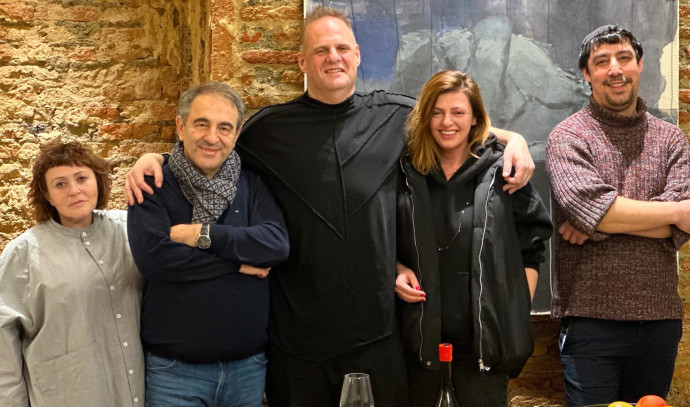World
State of the Union: Europe's divisions over the Middle East
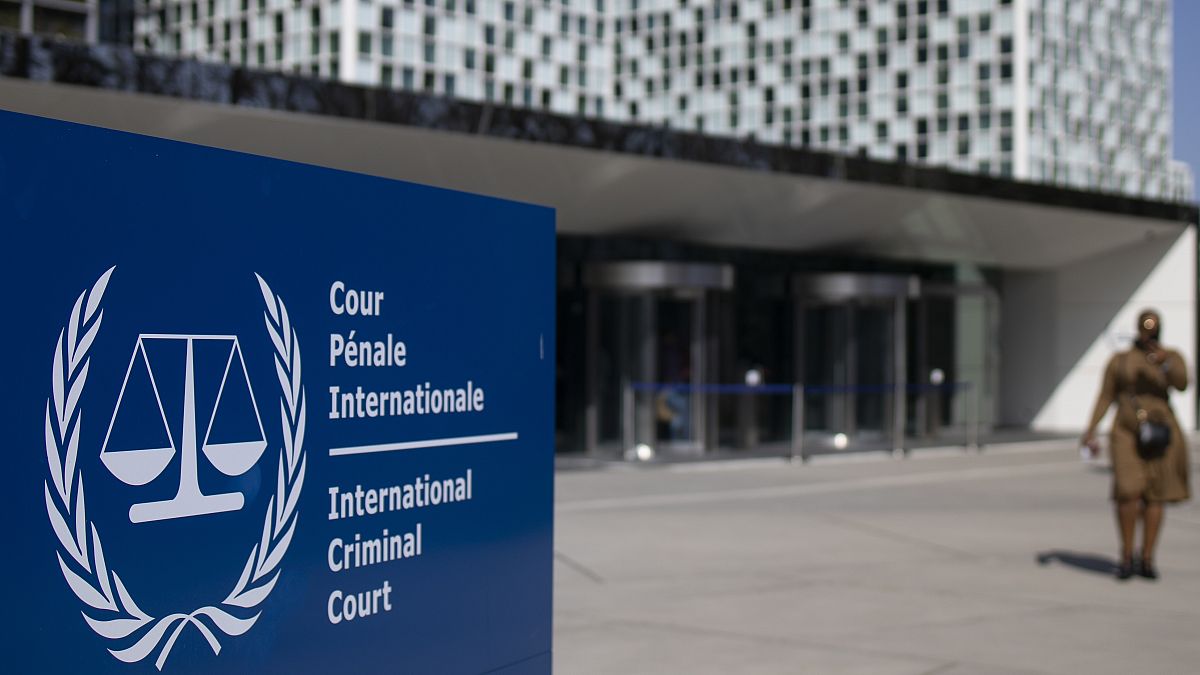
This edition of State of the Union focuses on the divisions within the EU over the Middle East, western hesitations to arm Ukraine, Moldova’s growing ties with the EU and the release of a commemorative coin to remember D-Day.
This week, we witnessed deep divisions between EU member states over the ongoing conflict in the Middle East – once again.
The reason was the decision by the International Criminal Court to seek arrest warrants against Israel’s prime minister and his defence chief as well as against three Hamas leaders.
Reactions ranged from welcoming the Court’s decision — in Belgium, France and Slovenia — to rebuking it in various forms — Germany, Austria and the Czech Republic.
The disunity was also on display when Ireland and Spain together with Norway moved to recognise Palestine as an independent state – something that had been discussed for quite a while.
“Quite frankly, because we must keep the hope, the dream and the destination of a two-state solution alive at a time when, sadly, others are working to undermine that,” Irish Prime Minister Simon Harris told Euronews.
“Ireland would have much preferred to have done this as part of a peace process. But we can’t wait forever. It’s an awful long time, many decades, since the Oslo Accords.”
Ukraine air defence
There is more European unity regarding Ukraine – on the surface. But when it comes to arms shipments, action hasn’t always matched words.
Western allies are taking too long to make key decisions, Ukraine complained, at a time when Russia seems to be stepping up its offensive in the north-east.
In the face of relentless Russian attacks, Germany’s foreign minister Annalena Baerbock, during a visit to Kyiv, warned that the country needed to boost its air defences – with Western help.
“Some of the rockets and missiles could be brought down by air defence, but obviously not all of them. And this is why I am calling worldwide to increase the air defence support.”
Moldova’s EU future
Watching the war very closely is Moldova, a country sandwiched between EU and NATO member Romania, and Ukraine.
The former Soviet republic has long been defying warnings from Moscow that closer Western integration could see it face Ukraine’s fate.
Nonetheless, Moldova signed a defence partnership with Brussels this week, a step designed to tie the country closer to the EU. The country is a candidate to join the bloc and formal talks are expected to begin next month.
For more on this, we spoke to Daniela Vidaicu, executive director of the Moldova Soros Foundation.
Euronews: So, how significant are the EU accession talks for the Moldovan public, how do people see EU membership?
Vidaicu: Well, the upcoming inter-governmental conference to be held in the nearest future is the most important political event for the pro-European Moldovan population. (…) Moldova is an inclusive society, it managed to achieve very good milestones in implementing national and domestic reforms so that the country and the society is transformed. And the negotiations should really move forward to be irreversible. For Moldovans, as you ask, both for those who are living in the country, but also for those that are living abroad in EU member states (and) holding already European citizenship, the European integration of Moldova is very important as a development plan and the most, probably, important strategic plan since its independence.
Euronews: We hear a lot about Russian disinformation – tell us what’s happening?
Vidaicu: Well, unfortunately, Moldova is one of the most affected European countries by Russian propaganda, which is very much coordinated by the Russian parties, the Russian media, the Russian social networks and influencers. Since the Russian invasion of Ukraine, Moldova started to face a very complicated, complex and aggressive hybrid war that undermines its development, its social cohesion, independence and security. And the goal actually is to increase the population polarisation and scepticism towards the European integration of the country and to keep the country under the Russian control, actually. So, the fake news, the disinformation, the Russian manipulation and interference target social or economic or political Moldovan vulnerabilities to keep the country in poverty and to undermine the European development of the country.
Euronews: There is a constitutional referendum coming up, there will be elections in October – how are these campaigns going, and to what extent is the EU part of the debate?
Vidaicu: Yes, indeed. In October 2024, Moldova is going to host two important electoral events. Both events are considered to be very relevant and very crucial for the Moldovan future and are going to happen on the same day. We have the pro-European government and the president, who announced his intention to run for the second mandate, civil society and media who are supporting the European integration. And we have the pro-Russian parties and Russian media that are trying to convince the population not to go to the referendum, to boycott the referendum or to vote against the referendum.
June 1944 – June 2024
In a few weeks, the Allies will mark the 80th anniversary of D-Day, that were the beginning of World War II and the liberation of Europe from the Nazis.
As a tribute to the fallen and to surviving veterans the British Royal Mint unveiled a commemorative coin depicting soldiers disembarking from a landing craft.
More than two million soldiers, sailors, pilots, medics and other people from a dozen countries were involved in Operation Overlord.
And nearly 160,000 troops hit the codenamed beaches of Utah, Omaha, Gold, Juno and Sword on June 6th, 1944.
A few days ago, to mark the coin’s release, its design was recreated in Normandy – on Gold Beach. Quite appropriate.
At 35 meters across, the sand art served as a reminder of the bravery and sacrifices of allied troops – for a few days.
The coin, on the other hand, is permanent.

World
Steven Spielberg Throws Apple Watch at ‘Sugarland Express’ 50th Anniversary and Remembers Finding ‘Jaws’ Script ‘Sitting Out’ in Producer’s Office

Apple, or at least its technology, was worried about the health and well-being of Hollywood’s greatest director.
In the middle of Steven Spielberg‘s Tribeca Festival talk on Saturday, where the filmmaker was celebrating the 50th anniversary of his debut feature, “The Sugarland Express,” he was interrupted by his Apple watch with a message that read “It looks like you’ve taken a hard fall.” Spielberg jokingly said “I’m not going to press the SOS [button]” before throwing it on the ground. “I’ll pick it up later,” he said, only to retrieve it a few minutes later when it started issuing some sort of distress signal.
Before the Q&A began, a taped message from “The Sugarland Express” star Goldie Hawn appeared on the screen, thanking Spielberg and reminiscing about the pivotal moment in her career—and his. The film was released in 1974, just one year before “Jaws,” and even though it received good reviews, Universal pulled it from theaters after two weeks because of lackluster box office results. “You’re the first audience to ever see ‘Sugarland Express’ in 50 years,” Spielberg said to a packed audience at the BMCC in Lower West Side Manhattan.
The three-time Academy Award-winning filmmaker told moderator and Variety Executive Editor Brent Lang that he was inspired to make the movie after reading an article with the headline “Modern Day Bonnie and Clyde” in a local Los Angeles Valley newspaper, The Citizens News. “It was the story of this couple in Texas, Bobby and Ila Fae Dent who, in order to get their baby back from child welfare, led a multi-car police chase through Texas, and it just seemed like an incredible story,” Spielberg said. He then sent the article to his friends Hal Barwood and Matthew Robbins and asked them if they wanted to work together and write a script.
But Universal wasn’t going to finance the film without a big star’s name above the title. “The movie wouldn’t have gotten made without her,” Spielberg said. Beyond her bankability, Spielberg felt that Hawn was a great fit for the role of Lou Jean Poplin, one of the naive cop car hijackers. “There was an element of the character, a bucolic element, that reminded me of the simplicity of Goldie’s heart,” he said.
However, filling out the rest of the ensemble inspired Spielberg and his casting director Shari Rhodes to look much farther afield from Hollywood. “I said to Shari, ‘Can you get some real people to be in this movie? Why does everybody have to be an actor? Why can’t you go into a bar and find Buster Daniels? Find a drunk for me,’” Spielberg joked. “She went into a bar, and she pulled this old guy out.” And he ended up being the well-lubricated passenger in the backseat when Hawn and her on-screen husband Clovis (played by William Atherton) steal a cop car and take a patrolman (Michael Sacks) hostage.
Since most of the film takes place in a car that is being followed by a caravan of police cars, news trucks, lookie-loos and well-wishers, Lang asked Spielberg if he thought of the movie during the O.J. Simpson Bronco chase. “I did! I did!” Spielberg replied. “I said, ‘Shit, they’re stealing my thunder!’”
“Sugarland Express” was also the beginning of his legendary collaborations with composer John Williams, and the pair have since worked together on “Jaws,” “Raiders of the Lost Ark,” “E.T. the Extra-Terrestrial,” “Jurassic Park,” “Schindler’s List” and many more. “I had been such a rabid fan of John’s scores, I used to collect soundtrack albums since I was a kid,” Spielberg said. “I vowed that if I ever get a chance to make a feature film, whoever this, I assumed he was British, guy John Williams, I want him to be the one to score it.”
He continued, “When ‘Sugarland’ was a reality…one of the first people I got in touch with was John. We met and had lunch and that was the beginning of…this is our 51st year working together.” To which the audience cheered.
Working on “Sugarland Express” with producers Richard Zanuck and David Brown led him to work with them again on “Jaws.”
“They had the galleys of this book in their office just sitting out called ‘Jaws’ I didn’t know what it was I was intrigued, and I went over to the assistant of Dick and I said, ‘Can I read this?’” Spielberg said. “I read it over the weekend and I was floored by it. I asked him if they would consider having me direct this, and there had already been a director assigned to it. Then about a month later when that didn’t work out they offered me the movie.”
In a year, when “Jaws” took a bite out of the box office, everyone would know Spielberg’s name and he’d be no one’s second choice to direct a movie about a shark, some dinosaurs or all manner of visitors from outer space.
Bonus trivia: The baby that Hawn and Atherton are trying to reunite with is played by Zanuck’s son, Harrison.
World
Hezbollah bigger challenge than Hamas to Israel: ‘Crown jewel in the Iranian empire of terror’
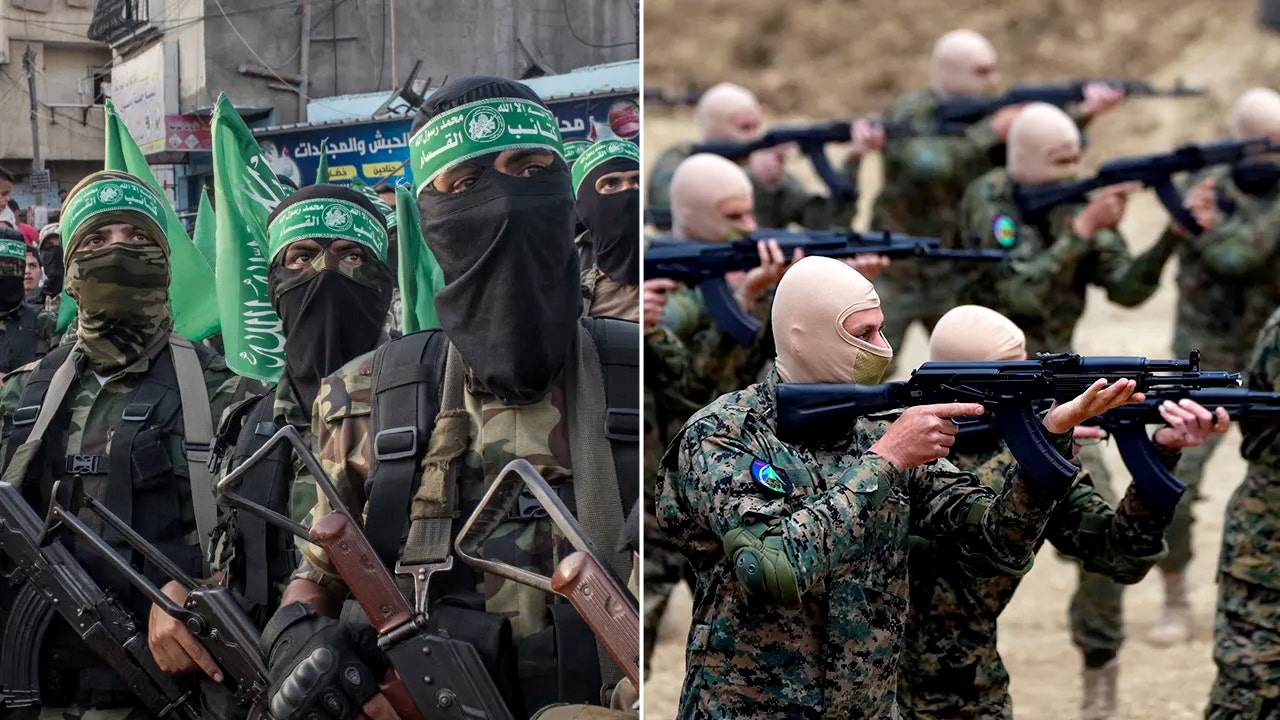
JERUSALEM — With Israel on the verge of a third full-blown war against Hezbollah because of the Lebanese organization’s constant firing of deadly missiles, drones and rockets, the differences and similarities between Hezbollah and Hamas are now under the microscope.
The Islamic Republic of Iran finances the Mideast terrorist movements Hamas and Hezbollah, who have declared war on Israel and who are also responsible for committing numerous terrorist attacks against American civilians and military service personnel.
Fox News Digital contacted experts for a tale-of-the-tape analysis on Hamas, which is situated in the southern Gaza Strip, and Hezbollah, which is the de facto ruler of the Lebanese state on Israel’s northern border. Israel has fought two wars against Hezbollah, in 1982 and in 2006.
“Hezbollah is the crown jewel in the Iranian empire of terror and evil and is by far the most powerful Iranian proxy equipped with nation state capabilities and even with more firepower than several European militaries have today,” Jonathan Conricus, senior fellow at the Foundation for Defense of Democracies and a former IDF spokesman told Fox News Digital.
HEZBOLLAH TERRORISTS LAUNCH MASSIVE ROCKET ATTACK ON ISRAEL AMID MOUNTING TENSIONS
In this Feb. 13, 2016, file photo, Hezbollah fighters hold flags as they attend the memorial for slain leader Sheik Abbas al-Mousawi, who was killed by an Israeli airstrike in 1992, in Tefahta village, south Lebanon. (AP Photo/Mohammed Zaatari, File)
Despite widespread poverty and economic instability in Iran, the Islamic Republic is also a generous funding source of Hezbollah, providing the Lebanese terrorist organization with over $700 million a year, according to the Israel Defense Forces and the U.S. State Department. Joint military cooperation between Iran’s regime and Hezbollah has been a longstanding feature in Lebanon, Syria and throughout Europe with respect to terrorism and war planning.
“In a military comparison, Hezbollah is far more powerful than Hamas across the board in every military metric. In terms of the amount of rockets they have, the range, the accuracy or the payload or size of the warhead, also in terms of the amount of personnel, armed fighters, their training and their equipment,” Conricus added.
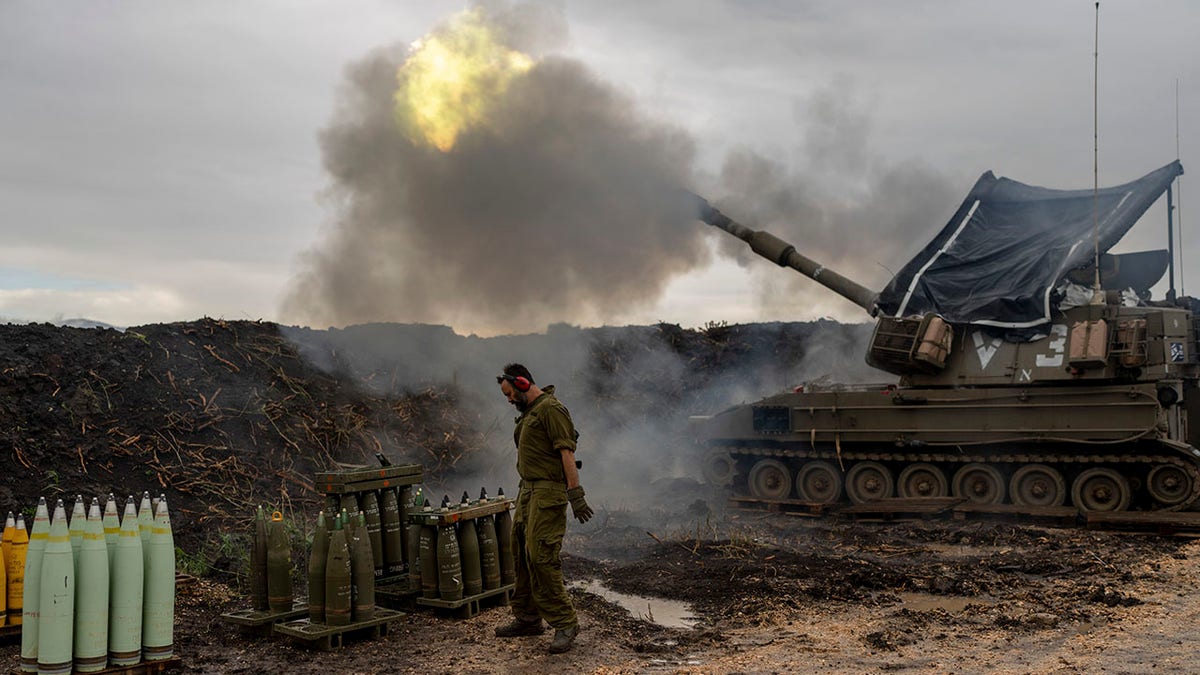
Israeli soldiers fire a mobile howitzer in the north of Israel, near the border with Lebanon Jan. 15, 2024. (AP Photo/Ohad Zwigenberg)
Hezbollah has amassed a massive arsenal of an estimated 150,000 rockets and missiles that are aimed at the Jewish state. The IDF has degraded Hamas’ supply of 20,000 rockets and missiles since the start of the war. However, Hamas was capable of launching eight rockets from the city of Rafah into Israel two weeks ago. Fox News Digital reported last week that Hezbollah launched over 200 missiles, rockets and drones into Israel.
The economics of Hamas and Hezbollah have similarities and differences in the scope of funding and military training from Tehran.
“Hezbollah and Hamas are both terror organizations funded mainly by Iran. Hezbollah’s loyalty is only to Iran. Hamas is for everyone who helps it,” said Edy Cohen, a Lebanese-born Israeli scholar of Hezbollah.
HEZBOLLAH BOMBARDS ISRAEL WITH ROCKETS, DRONES
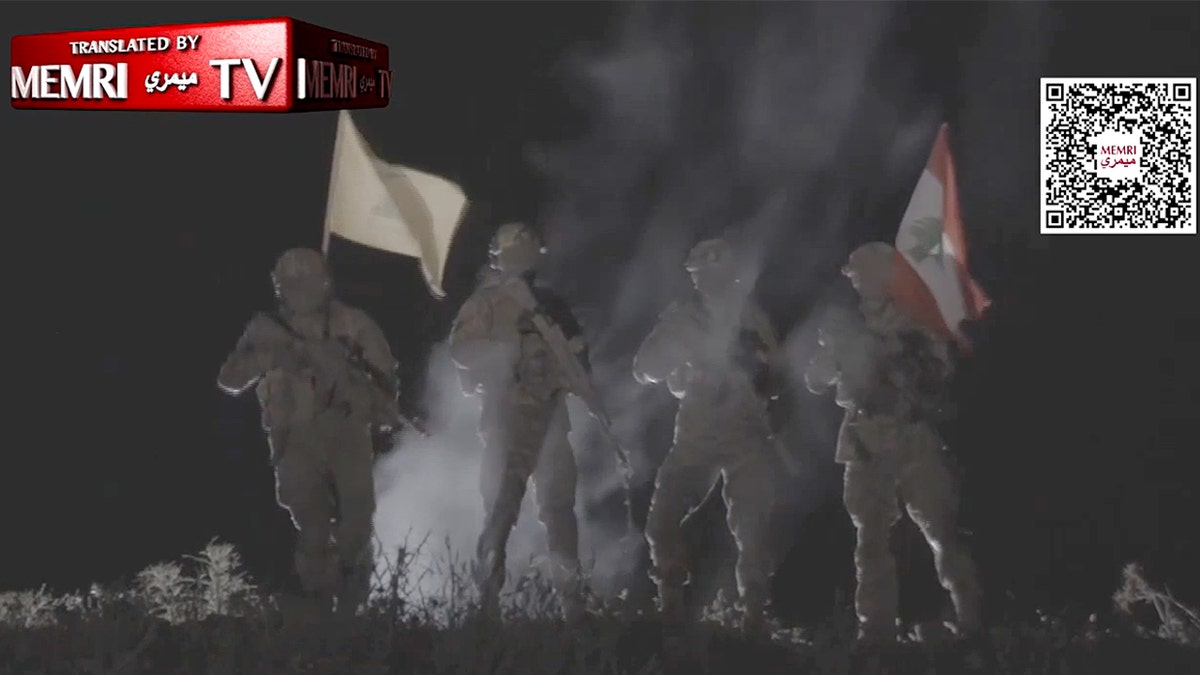
Hezbollah terrorist organization’s Radwan forces in training video. (Memri.org)
Cohen, a researcher at the Eitan, the Israeli Center for Grand Strategy, said “Hamas is under a sea blockage and cannot fly to other countries and cannot receive goods or arms easily. Hezbollah can.”
The number of terrorists fighting for both organizations varies. The IDF has reduced Hamas’ terrorist force by nearly 50% since the start of the war to between 9,000 and 12,000 combatants.
“Under the guidance of Hezbollah leader Hassan Nasrallah, the group boasts a troop strength of 20,000 to 25,000 full-time fighters, with additional tens of thousands in reserves,” the IDF wrote on its website. “Hezbollah’s elite Radwan Unit is particularly noted for its combat proficiency and strategic importance in conflicts across the region. This particular unit … was established with assistance from Iran’s Quds force.”
Walid Phares, co-president of #EducateAmerica and a professor of Middle East Studies, told Fox News Digital the first principal difference between Hamas and Hezbollah is “Hamas comes from the Muslim Brotherhood organizationally and ideologically, so it is a Sunni extremist group, a chapter of Ikhwan among many chapters in the region.”
Ikhwan is an Arabic word for the Muslim Brotherhood.
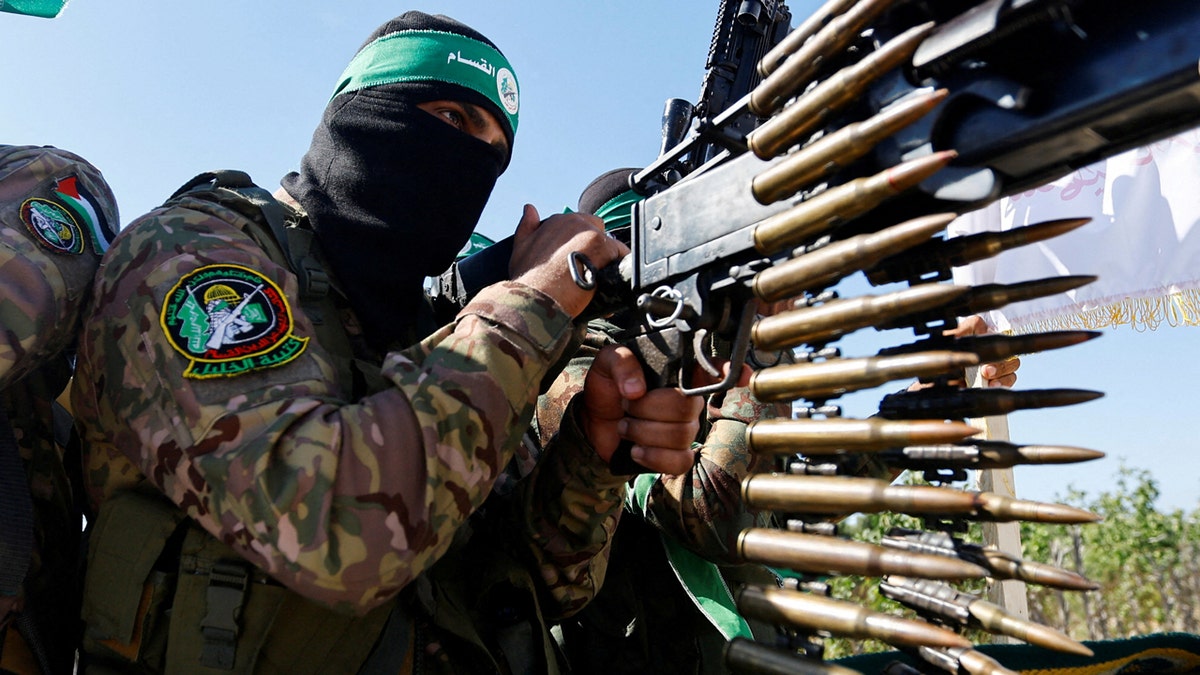
A terrorist from Hamas takes part in a military parade to mark the anniversary of the 2014 war with Israel near the border in the central Gaza Strip July 19, 2023. (Reuters/Ibraheem Abu Mustafa/File Photo)
He added that “Hezbollah comes from an opposite side. They are Shiites, but Jihadi Shiites, made of Lebanese Shia Islamists who have been recruited (and funded) by the Islamic Revolutionary Guard, or the Sepah Pasdaran as early as 1980. They were launched by the Islamic Republic in northern Bekaa that year and marched south all the way to the southern suburb of Beirut and then to the south after Israel started to withdraw.”
ODDS OF ISRAEL-HEZBOLLAH WAR ‘INEVITABLE,’ EXPERTS FEAR: ‘TOTALLY PESSIMISTIC’

Prime Minister Benjamin Netanyahu visited the IDF Gibor base in Kiryat Shmona, where he was briefed by 769th Brigade Commander Avraham Marciano and Northern Command Home Front coordinator Brig.-Gen. (Res.) Alon Friedman June 5, 2024. (Israeli Government Press Office)
Phares, co-host of the popular “War and Freedom” podcast, said Hamas’ “ultimate goal is to destroy Israel, establish a Taliban-like emirate or state in Palestine, but, more importantly, have that Islamic entity join a new Caliphate across the region. Hamas as such is not a ‘nationalist’ group, but a Pan-Islamist organization.”
In contrast to Hamas, Phrase noted that Hezbollah believes “in exactly the doctrine of the Iranian regime. That is to establish a Khomeinist republic in Lebanon to join the sister Islamic Republic in Iran, and also in Iraq and Yemen, and eventually form a ‘parallel’ Shia Khomeinist (Jihadist) type of Caliphate, known as Imamate, Shia Islamists reject the Sunni Caliphate.”
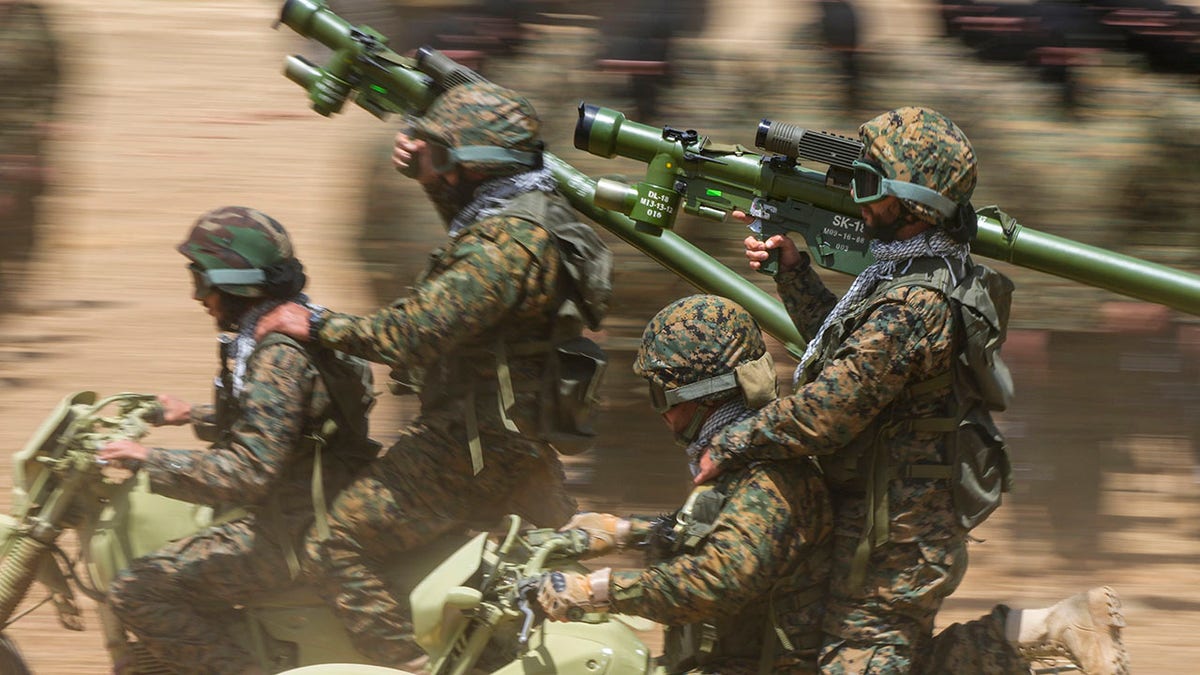
Hezbollah Radwan forces training in Southern Lebanon near the Israeli border. (AP/Hassan Ammar)
The Islamic revolutionary Ayatollah Ruhollah Khomeini founded the Islamic Republic of Iran in 1979, with a mission to export his Shia Islamism across the world.
“So, they are at polar opposites ideologically, how did they come together and what is common between them. What is common is, first, that they both want to destroy the Zionist entity [Israel]. That’s the ultimate joint goal. Then, they both want to bring down all Arab regimes who are with peace or are obstructing their jihad. They are both enemies of America,” Phares said.
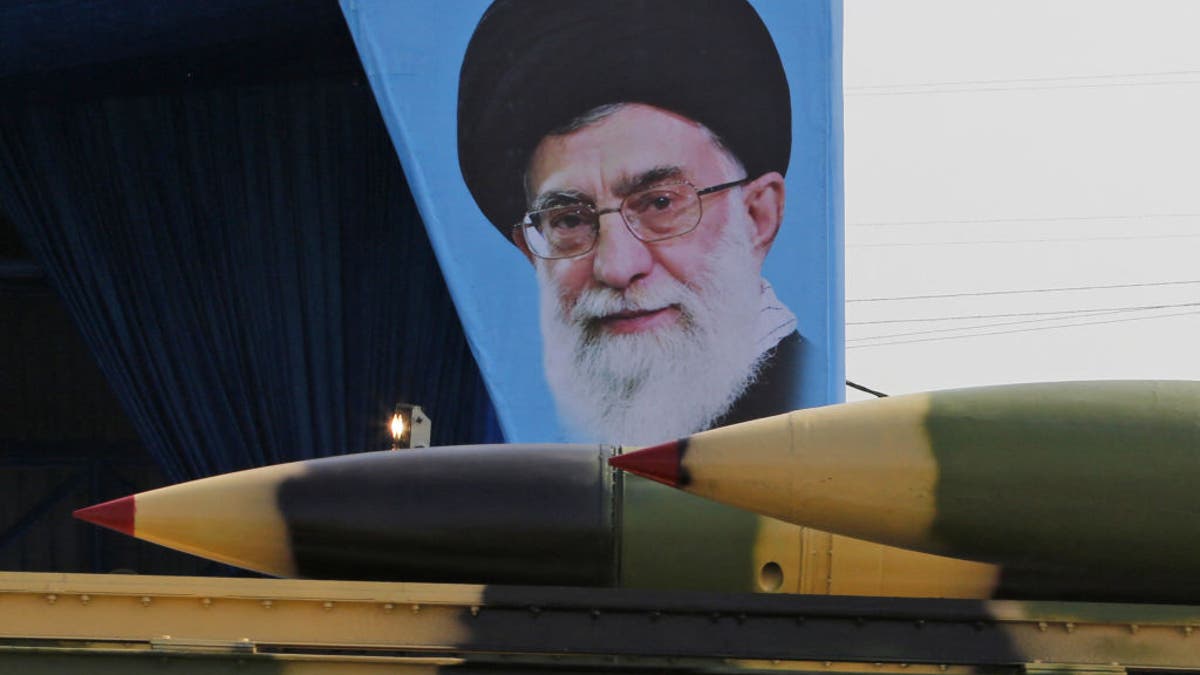
An Iranian military truck carries surface-to-air missiles past a portrait of Iran’s Supreme Leader Ayatollah Ali Khamenei during a parade on the country’s annual army day April 18, 2018, in Tehran. (Atta Kenare/AFP via Getty Images)
The Iranian regime’s financing of both terrorist movements is a crucial factor, according to Mideast experts, in understanding jingoism in the region and the destabilization of the Levant and the Islamic heartland in the Middle East.
Qatar hosts the Hamas political leader Ismail Haniyeh, who told the Qatari-owned Al Jazeera network in 2022— two years before Hamas launched its Oct. 7 invasion into southern Israel — that Tehran funnels at least $70 million to Hamas each year.
“Iran stands at the forefront of supporting the cause and [the] people of Palestine,” Haniyeh said in March.
NETANYAHU SAYS ISRAEL ‘PREPARED FOR VERY INTENSE ACTION’ AGAINST IRAN-BACKED HEZBOLLAH AMID RISING TENSIONS
The intense relations between Hamas and Hezbollah stem from the mid-1990s.
Counterterrorism expert Bruce Hoffman also noted in a June 14 article on the website of the Council of Foreign Relations that “some five hundred Hamas fighters were trained in Iran in preparation for the October 7 attacks, a reflection of Iran’s longstanding support of Hamas.”
Phares explained that Hamas and Hezbollah came together in 1994-1995 when “hundreds of Hamas cadres and leaders were exiled by Israel to south Lebanon. They were hosted by Hezbollah, who linked them up with the regime in Tehran. They were received, funded and armed. They were told the two Jihadisms can work together despite the Sunni and Shia divide. “
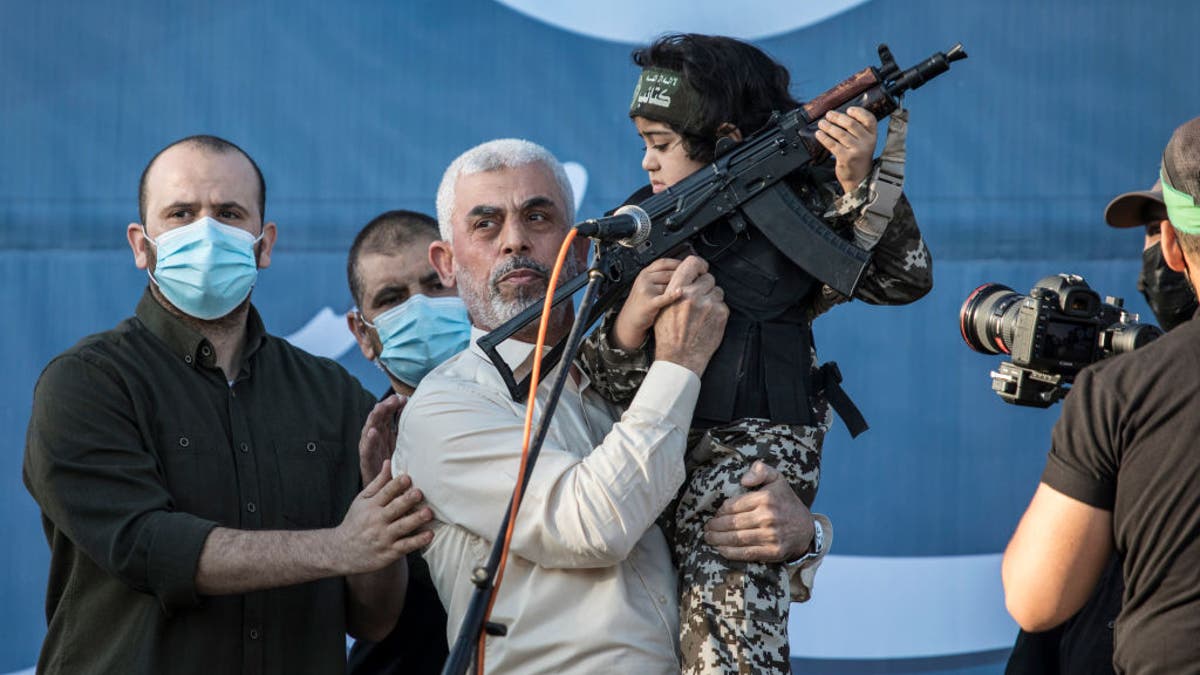
Yahya Sinwar, center, the elected leader of Hamas, appears during a ceremony for fighters killed by Israeli air strikes at Yarmouk football stadium May 24, 2021, in Gaza City, Gaza. (Laurent Van der Stockt/Getty Images)
He said Hamas embraced the Shia side to the “point that in 2011 they eventually sided with [Syria President Bashar] Assad’s (pro-Khomeinist) regime against Sunni Salafi Jihadi factions. That was a major crisis for Hamas, accused by Sunnis of betraying them. But, eventually, when Assad regained ground in Syria, and the Islamic Regime shifted the fight to Gaza, Hamas regained ‘Jihadi notoriety’ in the region.”
“Strategically speaking, Hezbollah is currently enjoying a situation where it has Israel exactly where it wants it. And Israel has indeed achieved quite a lot of military achievements. But, on the strategic level, Hezbollah is benefiting from an attrition in Israeli capabilities and from a very challenging diplomatic situation,” Conricus, the former IDF spokesman, noted.
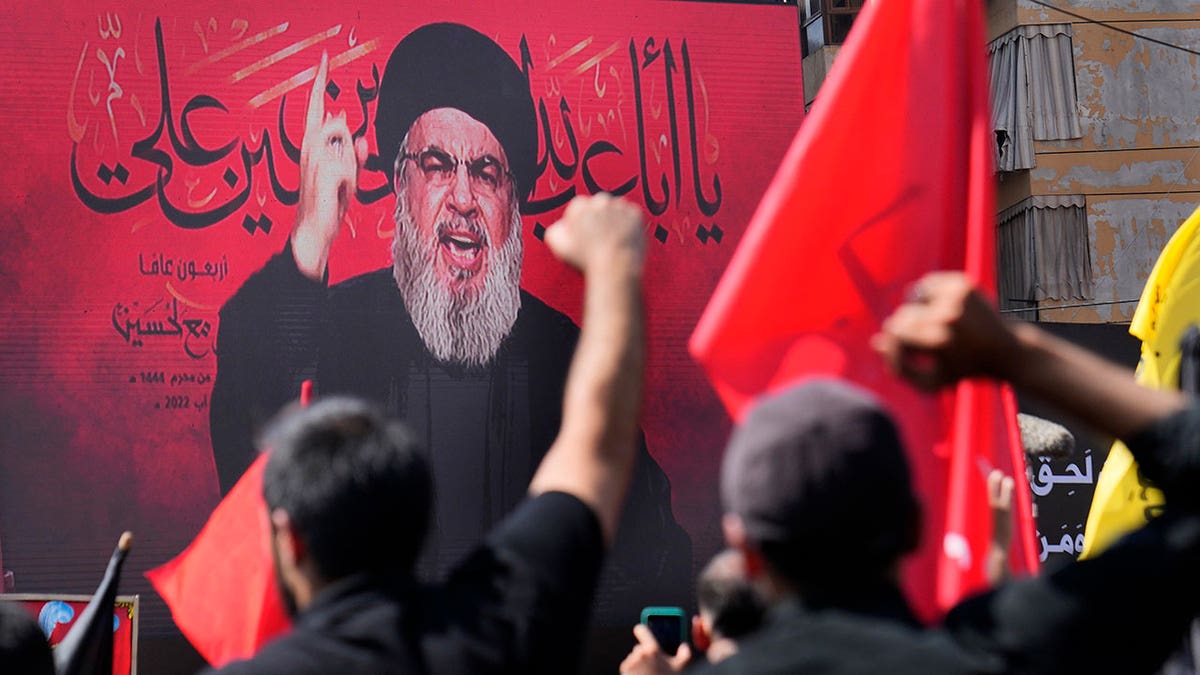
Hezbollah leader Sheik Hassan Nasrallah speaks via a video link as his supporters raise their hands during the Shiite holy day of Ashoura in the southern suburb of Beirut, Lebanon, Aug. 9, 2022. (AP Photo/Hussein Malla)
“As long as the international community fails to understand the severity and doesn’t act with urgency in order to facilitate a diplomatic deal that will return Israeli civilians to their homes safely, the only other option that remains is the military one, which Israel, unfortunately, will have to use in order to implement the responsibility of any government to safeguard the lives of its civilians. I hope that can be avoided, but currently that does not seem to be the case.”
The U.S. has sanctioned both Hamas and Hezbollah as foreign terrorist organizations. The EU has merely sanctioned Hezbollah’s so-called “military wing,” a terrorist entity, while France has blocked the designation of a full terror proscription of Hezbollah. The EU sanctioned Hamas as a terrorist organization in 2003.
World
Al-Qaeda affiliate claims responsibility for June attack in Burkina Faso

The attack on June 11 was one of the deadliest suffered by the West African nation’s army.
An armed group linked to al-Qaeda, Jama’at Nusrat al-Islam wal-Muslimin (JNIM), has claimed responsibility for what it said was an attack on June 11 that killed more than 100 Burkina Faso soldiers in the Mansila area near the border with Niger, the SITE Intelligence Group said.
On Sunday, SITE quoted a JNIM statement as saying that five days ago “fighters stormed a military post in the town, where they killed 107 soldiers and took control of the site”.
Several videos shared online by JNIM showed raging gunfire around the army base. Another video showed a display of ammunition and dozens of weapons, and at least seven captured Burkina Faso soldiers.
June’s reported attack has been one of the deadliest suffered by the West African Sahel nation’s army.
Ulf Laessing, head of the Sahel programme at the Konrad Adenauer Foundation, told Al Jazeera that the government is trying to fight the armed groups but has not recruited professional soldiers to do so.
“They recruited 50,000 volunteers, many of whom got only a short period of training. So they’re kind of vulnerable to losses and it is not very efficient, unfortunately. Almost every day now, there are incidents like this,” he said.
“Right now you have 50-60 percent of [Burkina Faso’s] territory which is outside government control … The government is trying hard, they’re buying weapons, they have a military partnership with Russia but they’re not very successful.”
Niger and Mali are also struggling to contain fighting linked to al-Qaeda and ISIL (ISIS). The unrest is also threatening the stability of the Sahel region as the armed groups, who control swathes of territories in Burkina Faso and Mali, use them as bases to target southern coastal countries.
Laessing noted that while Mali and Niger have similar problems, their countries are much bigger.
“Burkina Faso is the smallest of the three and very densely populated … Whenever the army attacks, you have many more civilian victims, that makes it so brutal,” he said.
Over more than a decade, armed groups have killed thousands and displaced more than two million in Burkina Faso.
Moreover, the country has topped the recent Norwegian Refugee Council (NRC) list of the world’s most neglected displacement crises.
The violence killed more than 8,400 people last year, double the number of deaths from the previous year, according to the NRC.
About two million civilians were trapped in 36 blockaded towns across Burkina Faso by the end of 2023.
-

 News1 week ago
News1 week agoIsrael used a U.S.-made bomb in a deadly U.N. school strike in Gaza
-

 World1 week ago
World1 week agoRussia-Ukraine war: List of key events, day 833
-

 Politics1 week ago
Politics1 week agoGeorge Clooney called White House to complain about Biden’s criticism of ICC and defend wife’s work: report
-

 Politics1 week ago
Politics1 week agoNewson, Dem leaders try to negotiate Prop 47 reform off California ballots, as GOP wants to let voters decide
-

 World1 week ago
World1 week ago‘Bloody policies’: Bodies of 11 refugees and migrants recovered off Libya
-

 Politics1 week ago
Politics1 week agoEmbattled Biden border order loaded with loopholes 'to drive a truck through': critics
-

 World1 week ago
World1 week agoDozens killed near Sudan’s capital as UN warns of soaring displacement
-

 World1 week ago
World1 week agoVideo: U.S. Official Responds to Israeli Strike on a U.N. School in Gaza



